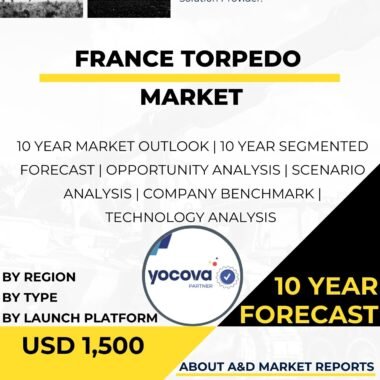Description
The Spain Torpedo Market is a crucial and rapidly evolving sector that plays a pivotal role in enhancing the country’s naval defense capabilities and supporting maritime security operations. Torpedoes are underwater weapons specifically designed for naval warfare, offering the Spanish Navy a potent means to engage and neutralize surface vessels and submarines. The Spain Torpedo Market is driven by factors such as the need to modernize the Spanish Navy’s naval fleet, enhance anti-submarine warfare (ASW) capabilities, secure maritime borders, and address emerging security challenges in the maritime domain.
The growth of the Spain Torpedo Market can be attributed to several key factors. First and foremost, Spain’s strategic geographical location as a maritime nation with an extensive coastline and maritime interests drives the demand for torpedoes to protect its territorial waters and exclusive economic zone.
Moreover, advancements in torpedo technology have significantly improved the performance and capabilities of modern torpedoes. These advanced weapons offer increased range, speed, and target detection features, ensuring a potent and reliable anti-surface and anti-submarine capability for the Spanish Navy.
The Spain Torpedo Market is also driven by the need to address asymmetric security threats and emerging challenges in the maritime domain. Torpedoes play a vital role in enhancing the Spanish Navy’s ASW capabilities, countering potential submarine threats, and safeguarding maritime trade routes.
Furthermore, torpedoes are essential for supporting Spain’s role in international maritime security operations. These weapons contribute to multinational naval task forces, participate in joint exercises, and demonstrate Spain’s commitment to global security and stability.
The versatility of torpedoes is another significant driver of market growth. These weapons can be adapted to various mission profiles, including anti-ship and anti-submarine warfare, providing the Spanish Navy with a comprehensive and adaptable underwater capability.
However, the growth of the Spain Torpedo Market also presents challenges. One of the primary concerns is ensuring the maintenance and modernization of the existing torpedo inventory. Torpedoes have long operational lifespans, and continuous investment in upgrades and modernization is essential to keep them at the cutting edge of technology.
Moreover, addressing the issue of budget constraints is essential to sustain torpedo acquisition and maintenance programs. Torpedoes are expensive weapons, and careful financial planning is necessary to ensure a balanced and effective naval fleet.
Another challenge lies in ensuring the safety and reliability of torpedoes during extended underwater operations. Comprehensive testing, quality control, and regular maintenance are crucial to ensuring the effectiveness and safety of torpedoes in combat situations.
Furthermore, the Spain Torpedo Market must address regulatory considerations and compliance with international maritime laws and treaties. Ensuring that torpedoes adhere to international arms control regulations and environmental standards is necessary for promoting cooperation and interoperability with other naval forces.
In conclusion, the Spain Torpedo Market is a critical enabler of underwater warfare capabilities for the Spanish Navy. The market’s growth is driven by Spain’s strategic maritime interests, advancements in torpedo technology, and the need to address security challenges effectively. Torpedoes enhance the overall ASW and anti-surface warfare capabilities, providing the Spanish Navy with a powerful and reliable underwater weapon for successful and effective operations. However, challenges related to maintenance and modernization, budget constraints, safety and reliability, and regulatory compliance must be addressed to ensure the continuous effectiveness and resilience of torpedoes in meeting defense requirements and supporting Spain’s strategic interests and maritime security. As technology continues to evolve, torpedoes will remain a vital aspect of modern naval defense strategies, shaping the future of underwater warfare and maritime operations in Spain and beyond.




